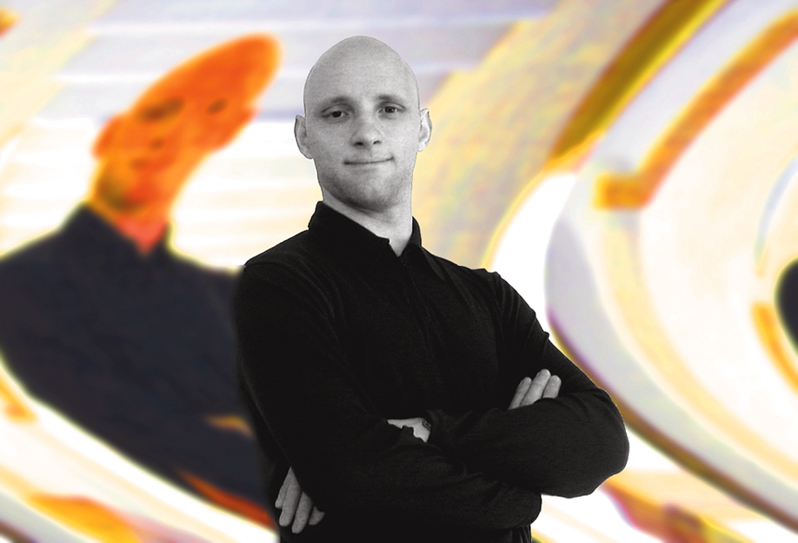I n t e r a k t i o n s - L a b o r
Klaus Friedrich
(St.Ingbert, Germany)

Geboren 1969 in Frankfurt/Main, gilt Klaus Friedrich heute als einer der wenigen Kunstschaffenden in Deutschland, die sich konsequent mit den Möglichkeiten digitaler Reproduktionsmedien auseinandersetzen. Mit ihrer Hilfe entwickelt der heute im Saarland lebende, vorwiegend projektbezogen arbeitende Künstler eindrucksvolle Unikate, in denen sich Fotografie, Malerei, Collage und klassische Drucktechniken zu einer ungewohnten Bildsprache mit ganz eigener Ästhetik verbinden. Kopierer, Computer und Faxgerät sind dabei für Friedrich "lediglich Werkzeuge" Werkzeuge, die es ihm erlauben, "scheinbar Vertrautes neu zu inszenieren und um weitere inhaltliche Dimensionen zu erweitern".
Entscheidend ist somit weniger die Art des Enstehungsprozesses als vielmehr das grundlegende Konzept hinter den Arbeiten. Dementsprechend stehen hier die Reproduktionsmedien nicht nur als zeitgenössische Gestaltungsmittel gleichberechtigt neben Pinsel und Leinwand, sondern sind zugleich auch stilistischer Ausdruck jener digitalen Revolution, die fast unbemerkt die Welt verändert hat. "Kopierte Wirklichkeiten", nennt Friedrich folgerichtig seine Werke, die fast immer auf eigenen fotografischen Vorlagen basieren.
Kopiert, gescannt, ganz oder teilweise verfremdet, bringt er diese dem jeweiligen Bildkonzept entsprechend in einen neuen Kontext, übermalt sie oder fügt sie kurzerhand zu verblüffenden Collagen zusammen. Elementares Gestaltungsmittel sind dabei transparente Trägerfolien, die seinen Copy-Collagen neben einer konkret räumlichen eine weitere, inhaltliche Dimension verleihen und die Vielschichtigkeit der Arbeiten auch formal aufgreifen. Entscheidend jedoch ist letztlich die Wahl des richtigen Ausschnitts. Bildfindung ist daher für Friedrich "nicht nur das bewusste Wahrnehmen der Dinge mit ’Kamera-BlickŒ, das Zusammenfügen unterschiedlicher Komponenten, sondern auch deren objektbezogenes Arrangement".
"Kunst muss erneuern, aber auch erinnern, Vergangenheit und Zukunft verbinden und den Blick schärfen". Dieses verbindende Element findet sich als Werkansatz in nahezu allen Werken Klaus Friedrichs und wird auch seinen Projektbeitrag im Rahmen des internationen Interaktions-Labors in Göttelborn prägen. Dabei möchte er den Begriff der "Interaktion" bewusst von den elektronischen Medien lösen und statt dessen anhand eines realen Ortes als wechselseitiges Zusammenspiel von Wahrnehmung und Reaktionsmustern interpretieren. Die als Zukunftsstandort ausgewiesene Grube Göttelborn wird demzufolge als universeller Mikrokosmos inszeniert, der sich der Außenwelt in Form kopierter Bildprozesse erschließt und letztlich allein durch die Interpretation des Betrachters seine spannenden Konstellationen offenbart. "Wie real ist dieser Ort, was verbirgt sich hinter so genannten Wirklichkeiten?", lautet dabei die zentrale Frage, die auf die Antwort hinausläuft, dass jeder scheinbar reale Ort im Grunde nur durch Interaktion existiert.
* * *
Born in Frankfurt in 1969, Klaus Friedrich is considered today as one of the few artists in Germany who experiment consistently with the possibilities of digital reproduction media. With these media, and working predominantly with project-oriented processes, Friedrich has developed impressive originals in which photography, painting, collage and classic printing technologies are combined into an unfamailiar language of images with a unique aesthetics. Copier, computer and fax machine are for Friedrich "solely tools" - tools allowing him to "reinvent the seemingly familiar and expand it into new dimensions of content".
Crucial for this type of work is therefore not so much the process of production but the concept behind the work. Accordingly the reproduction media stand here not only as contemporary means of composition next to paint-brush and canvas, but they are a contemporary stylistic expression of the digital revolution which has imperceptibly changed the world. "Copied realities" - this is how Friedrich consistently refers to his works that are based almost always on characteristic photographic models.
Copied, scanned, entirely or partially changed, he transports the works into a new context, overpaints them or joins them abruptly to surprising compositions. Transparencies are at the basis of composition; they lend these art works a concrete spatial dimensions and a further layer of content while formally reflecting the multiple layers of the pieces. The choice of a particular angle is decisive. Composing images is therefore for Friedrich "not only the perception of things with the camera eye, the joining of different components, but also the particular arrangement of objects".
"Art must renew, but must remember also, connect past and the future
and sharpen the gaze" ... This connecting element is found in almost
all of Friedrich's works and will also characterize his contribution to the
international Interaction Laboratory in Göttelborn. He would like to
deliberatly disconnect the concept of the "interactivity" from the
electronic media and interpret it instead in regard to the real site as a
convergence of perception and reaction patterns. The Mine, being considered
as future new-industry location, is therefore treated as a universal microcosm
that opens itself to the outside world in form of copied imaging-processes,
and finally opens its potentially exciting constellations only to the interpretation
of the spectator. "How real is this place, and what is concealed behind
so-called realities?" - this could be the central question that may request
an answer in such a way that each apparently real place in fact exists only
through interaction.